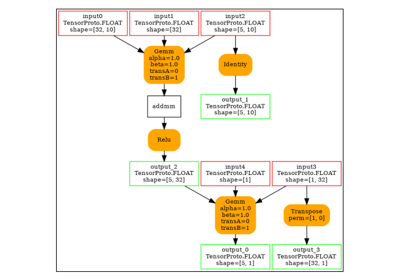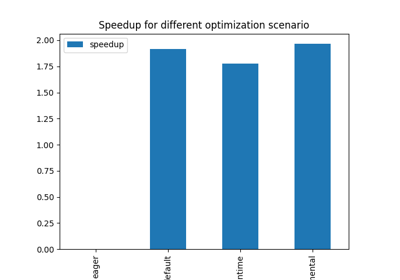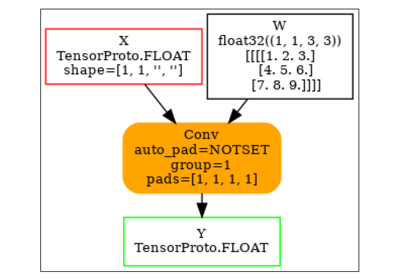Note
Go to the end to download the full example code.
101: Linear Regression and export to ONNX¶
scikit-learn and torch to train a linear regression.
data¶
import numpy as np
from sklearn.datasets import make_regression
from sklearn.linear_model import LinearRegression, SGDRegressor
from sklearn.metrics import mean_squared_error, r2_score
from sklearn.model_selection import train_test_split
import torch
from onnxruntime import InferenceSession
from experimental_experiment.helpers import pretty_onnx
from onnx_array_api.plotting.graphviz_helper import plot_dot
from experimental_experiment.torch_interpreter import to_onnx
X, y = make_regression(1000, n_features=5, noise=10.0, n_informative=2)
print(X.shape, y.shape)
X_train, X_test, y_train, y_test = train_test_split(X, y)
(1000, 5) (1000,)
scikit-learn: the simple regression¶
clr = LinearRegression()
clr.fit(X_train, y_train)
print(f"coefficients: {clr.coef_}, {clr.intercept_}")
coefficients: [ 1.49148391e-01 9.55477138e+01 4.27602676e+01 -5.16603994e-01
-9.13095100e-02], 0.15098552078709382
Evaluation¶
LinearRegression: l2=101.08471574277934, r2=0.9895516762682767
scikit-learn: SGD algorithm¶
SGD = Stochastic Gradient Descent
clr = SGDRegressor(max_iter=5, verbose=1)
clr.fit(X_train, y_train)
print(f"coefficients: {clr.coef_}, {clr.intercept_}")
-- Epoch 1
Norm: 89.74, NNZs: 5, Bias: -3.207615, T: 750, Avg. loss: 1192.340618
Total training time: 0.00 seconds.
-- Epoch 2
Norm: 100.77, NNZs: 5, Bias: -1.122405, T: 1500, Avg. loss: 93.318303
Total training time: 0.00 seconds.
-- Epoch 3
Norm: 103.38, NNZs: 5, Bias: -0.307030, T: 2250, Avg. loss: 55.821301
Total training time: 0.00 seconds.
-- Epoch 4
Norm: 104.26, NNZs: 5, Bias: -0.081255, T: 3000, Avg. loss: 52.718419
Total training time: 0.00 seconds.
-- Epoch 5
Norm: 104.47, NNZs: 5, Bias: 0.059221, T: 3750, Avg. loss: 52.405686
Total training time: 0.00 seconds.
~/vv/this312/lib/python3.12/site-packages/sklearn/linear_model/_stochastic_gradient.py:1608: ConvergenceWarning: Maximum number of iteration reached before convergence. Consider increasing max_iter to improve the fit.
warnings.warn(
coefficients: [ 0.21819782 95.36249001 42.64578842 -0.53980981 -0.14550926], [0.05922084]
Evaluation
SGDRegressor: sl2=101.49390416781107, sr2=0.9895093817126598
Linrar Regression with pytorch¶
class TorchLinearRegression(torch.nn.Module):
def __init__(self, n_dims: int, n_targets: int):
super().__init__()
self.linear = torch.nn.Linear(n_dims, n_targets)
def forward(self, x):
return self.linear(x)
def train_loop(dataloader, model, loss_fn, optimizer):
total_loss = 0.0
# Set the model to training mode - important for batch normalization and dropout layers
# Unnecessary in this situation but added for best practices
model.train()
for X, y in dataloader:
# Compute prediction and loss
pred = model(X)
loss = loss_fn(pred.ravel(), y)
# Backpropagation
loss.backward()
optimizer.step()
optimizer.zero_grad()
# training loss
total_loss += loss
return total_loss
model = TorchLinearRegression(X_train.shape[1], 1)
optimizer = torch.optim.SGD(model.parameters(), lr=1e-3)
loss_fn = torch.nn.MSELoss()
device = "cpu"
model = model.to(device)
dataset = torch.utils.data.TensorDataset(
torch.Tensor(X_train).to(device), torch.Tensor(y_train).to(device)
)
dataloader = torch.utils.data.DataLoader(dataset, batch_size=1)
for i in range(5):
loss = train_loop(dataloader, model, loss_fn, optimizer)
print(f"iteration {i}, loss={loss}")
iteration 0, loss=2720875.5
iteration 1, loss=196841.9375
iteration 2, loss=85080.1953125
iteration 3, loss=79213.7109375
iteration 4, loss=78801.4453125
Let’s check the error
TorchLinearRegression: tl2=101.36537040894598, tr2=0.9895226672258376
And the coefficients.
print("coefficients:")
for p in model.parameters():
print(p)
coefficients:
Parameter containing:
tensor([[ 0.1599, 95.0990, 43.1321, -0.3775, 0.2863]], requires_grad=True)
Parameter containing:
tensor([0.2348], requires_grad=True)
Conversion to ONNX¶
Let’s convert it to ONNX.
onx = to_onnx(model, (torch.Tensor(X_test[:2]),), input_names=["x"])
Let’s check it is work.
sess = InferenceSession(onx.SerializeToString(), providers=["CPUExecutionProvider"])
res = sess.run(None, {"x": X_test.astype(np.float32)[:2]})
print(res)
[array([[-117.064224],
[ 46.55126 ]], dtype=float32)]
And the model.
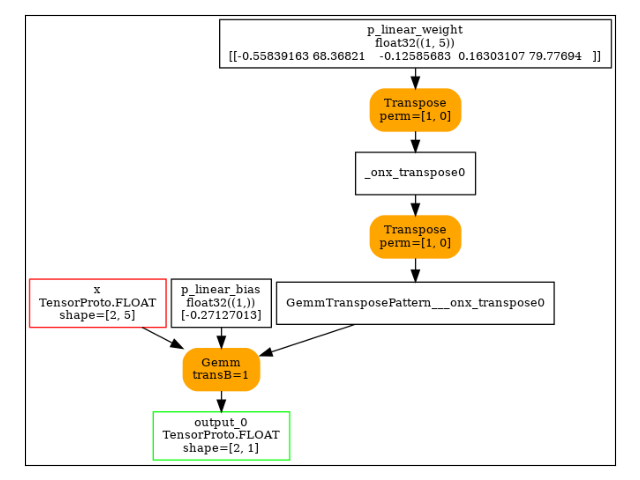
With dynamic shapes¶
The dynamic shapes are used by torch.export.export() and must
follow the convention described there. The dynamic dimension allows
any value. The model is then valid for many different shapes.
That’s usually what users need.
onx = to_onnx(
model,
(torch.Tensor(X_test[:2]),),
input_names=["x"],
dynamic_shapes={"x": {0: torch.export.Dim("batch")}},
)
print(pretty_onnx(onx))
opset: domain='' version=18
input: name='x' type=dtype('float32') shape=['batch', 5]
init: name='init7_s2_-1_1' type=int64 shape=(2,) -- array([-1, 1]) -- TransposeEqualReshapePattern.apply.new_shape
init: name='init7_s2_1_-1' type=int64 shape=(2,) -- array([ 1, -1]) -- TransposeEqualReshapePattern.apply.new_shape
init: name='linear.weight' type=float32 shape=(1, 5) -- DynamoInterpret.placeholder.1/P(linear.weight)
init: name='linear.bias' type=float32 shape=(1,) -- array([0.23478925], dtype=float32)-- DynamoInterpret.placeholder.1/P(linear.bias)
Reshape(linear.weight, init7_s2_-1_1) -> _onx_transpose_p_linear_weight0
Reshape(_onx_transpose_p_linear_weight0, init7_s2_1_-1) -> GemmTransposePattern--_onx_transpose_p_linear_weight0
Gemm(x, GemmTransposePattern--_onx_transpose_p_linear_weight0, linear.bias, transB=1) -> output_0
output: name='output_0' type=dtype('float32') shape=['batch', 1]
For simplicity, it is possible to use torch.export.Dim.DYNAMIC
or torch.export.Dim.AUTO.
onx = to_onnx(
model,
(torch.Tensor(X_test[:2]),),
input_names=["x"],
dynamic_shapes={"x": {0: torch.export.Dim.DYNAMIC}},
)
print(pretty_onnx(onx))
opset: domain='' version=18
input: name='x' type=dtype('float32') shape=['batch', 5]
init: name='init7_s2_-1_1' type=int64 shape=(2,) -- array([-1, 1]) -- TransposeEqualReshapePattern.apply.new_shape
init: name='init7_s2_1_-1' type=int64 shape=(2,) -- array([ 1, -1]) -- TransposeEqualReshapePattern.apply.new_shape
init: name='linear.weight' type=float32 shape=(1, 5) -- DynamoInterpret.placeholder.1/P(linear.weight)
init: name='linear.bias' type=float32 shape=(1,) -- array([0.23478925], dtype=float32)-- DynamoInterpret.placeholder.1/P(linear.bias)
Reshape(linear.weight, init7_s2_-1_1) -> _onx_transpose_p_linear_weight0
Reshape(_onx_transpose_p_linear_weight0, init7_s2_1_-1) -> GemmTransposePattern--_onx_transpose_p_linear_weight0
Gemm(x, GemmTransposePattern--_onx_transpose_p_linear_weight0, linear.bias, transB=1) -> output_0
output: name='output_0' type=dtype('float32') shape=['batch', 1]
Total running time of the script: (0 minutes 2.279 seconds)
Related examples

201: Use torch to export a scikit-learn model into ONNX
201: Use torch to export a scikit-learn model into ONNX
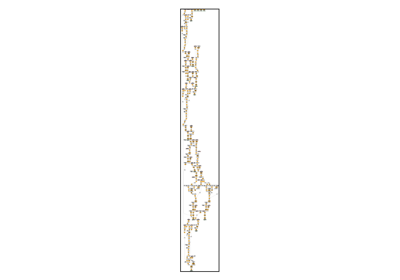
101: Onnx Model Optimization based on Pattern Rewriting
101: Onnx Model Optimization based on Pattern Rewriting
